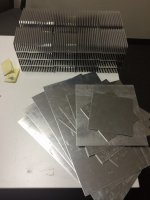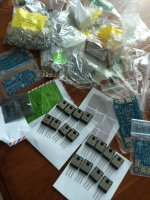Naturally, the one grade that is currently out of stock!You will need Grade B (Idss 6 - 12)
Thanks for the reply.
Thanks for the referral, ordered the Jfets from Spencer, he will ship this Saturday.Buy Toshiba Jfets from Spencer at fetaudio.com
I'm putting together my order at McMaster for all the fasteners to put the chassis together. Trying to get as much as I can on this order. What is the recommended size fastener for the chips to the heatsinks? In your build guide you have a hex headed bolt and a washer. Is it best to use the Keratherm pads from the DIY store?You're coming along nicely... What else is still on the shopping list?
Thanks in advance
Using a deluxe chassis from the diyAudio store?

Mounting hardware -
M3x5mm (PCB to standoff)
M3x10mm (Mosfet-heatsink)
M3 standoffs, 5mm thread depth (PCB-heatsink)
Fender washers (For mosfet)
( I don't know what exactly the screws are for the IEC, it's more a function of the actual piece you use, but likely countersunk M2 or M3)
Yes, use the Keratherm pads from the store.

Mounting hardware -
M3x5mm (PCB to standoff)
M3x10mm (Mosfet-heatsink)
M3 standoffs, 5mm thread depth (PCB-heatsink)
Fender washers (For mosfet)
( I don't know what exactly the screws are for the IEC, it's more a function of the actual piece you use, but likely countersunk M2 or M3)
Yes, use the Keratherm pads from the store.
Last edited:
Using a deluxe chassis from the diyAudio store?

Mounting hardware -
M3x5mm (PCB to standoff)
M3x10mm (Mosfet-heatsink)
M3 standoffs, 5mm thread depth (PCB-heatsink)
Fender washers (For mosfet)
( I don't know what exactly the screws are for the IEC, it's more a function of the actual piece you use, but likely countersunk M2 or M3)
Yes, use the Keratherm pads from the store.
Thanks for the info!
But no, I'm not using the DIY chassis. That would be too easy 😉
I'm building my own. I just received my aluminum flat stock pieces for the top and bottom, front and back, and platform for the large dia caps.
Now a few hours of drilling and taping ahead of me

I like using these for "washers" when bolting the FETs and diodes to the heatsink
http://www.digikey.com/product-detail/en/290-1AB/345-1020-ND/340318
Extra cooling is always good 🙂
http://www.digikey.com/product-detail/en/290-1AB/345-1020-ND/340318
Extra cooling is always good 🙂
Last edited:
Thanks for the info!
But no, I'm not using the DIY chassis. That would be too easy 😉
I'm building my own. I just received my aluminum flat stock pieces for the top and bottom, front and back, and platform for the large dia caps.
Now a few hours of drilling and taping ahead of me
View attachment 438186
Haaha same here...🙂 seeing all that aluminum makes me want to build something....
Good luck.
Looks like a good idea! Cost is not much.I like using these for "washers" when bolting the FETs and diodes to the heatsink
Invalid Request
Extra cooling is always good 🙂
Some guests in town this week, so in a couple days the drilling will start. Fasteners from McMaster shipped this morning.Haaha same here...🙂 seeing all that aluminum makes me want to build something....
Good luck.
Should I buy the soft start and speaker protection boards from the DIY store?
What about a slow charge circuit? I read some of the posts, but due to my experience, I would prefer a proven design, boards, BOM, etc. any ideas?
I have a 1500va trans and 448,000uF caps for each monoblock.
What about a slow charge circuit? I read some of the posts, but due to my experience, I would prefer a proven design, boards, BOM, etc. any ideas?
I have a 1500va trans and 448,000uF caps for each monoblock.
More parts have arrived, fasteners from McMaster, Toshiba K170 and J74 Jfets from Spencer, Toshiba 2SJ201/2SK1530 Mosfets from Tech-DIY, Keratherm insulators, and speaker and soft start boards from DIY store;

The mosfets from Tech-DIY were ordered matched. This is how they are marked;
K1530
1.72, 172, 1.72, 171, 2.20, 2.21, 2.21, 2.21
J210
222, 222, 223, 223, 194, 195, 195, 195
Are these number close enough for this build?
So many parts to order! I'm putting a spread sheet together with all the boards BOM's marked up with what I'm buying different and pricing for comments.
I'm trying to buy all the hard to find and long lead parts first.

The mosfets from Tech-DIY were ordered matched. This is how they are marked;
K1530
1.72, 172, 1.72, 171, 2.20, 2.21, 2.21, 2.21
J210
222, 222, 223, 223, 194, 195, 195, 195
Are these number close enough for this build?
So many parts to order! I'm putting a spread sheet together with all the boards BOM's marked up with what I'm buying different and pricing for comments.
I'm trying to buy all the hard to find and long lead parts first.
The Mosfet are completely and overkilly well matched. You have 2 sets of 4 per channel.
There is no reason to match N to P, so don't worry about it at all.
The rest of the parts are available form Mouser or Digi-Key, in stock an ready to ship Monday morning.
Comments -
DO NOT install the soft-start and/or DC protection board until the amp is completely operative, tested and burnt-in. Use the CL-50 or -60 for inrush protection in the meantime.
There is no reason to match N to P, so don't worry about it at all.
The rest of the parts are available form Mouser or Digi-Key, in stock an ready to ship Monday morning.
Comments -
DO NOT install the soft-start and/or DC protection board until the amp is completely operative, tested and burnt-in. Use the CL-50 or -60 for inrush protection in the meantime.
Thanks for taking time to comment and the confirmation on the Mosfet's.The Mosfet are completely and overkilly well matched. You have 2 sets of 4 per channel.
There is no reason to match N to P, so don't worry about it at all.
The rest of the parts are available form Mouser or Digi-Key, in stock an ready to ship Monday morning.
Comments -
DO NOT install the soft-start and/or DC protection board until the amp is completely operative, tested and burnt-in. Use the CL-50 or -60 for inrush protection in the meantime.
Buying straight from the published F5 Turbo BOM would be too easy 😉 and does not show the magnitude of all the other parts that need to be purchased to build the whole amplifier. Especially if you color outside the lines a little.
I'm assuming your comments about the soft-start and speaker protection implementation are referencing to independently verify the operation of each system of the amp prior to integration to minimize troubleshooting? Or other?
I suggest you use the mains bulb tester for all power ups until all modifications are complete.
The bulb tester also operates as a soft start due to the cold filament resistance.
The bulb tester also operates as a soft start due to the cold filament resistance.
Buying straight from the published F5 Turbo BOM would be too easy
But strongly suggested.
independently verify the operation of each system of the amp prior to integration to minimize troubleshooting?
Yes. Build the amp. Get it working. Build the soft start, install, get working properly, build DC board, get operative, install.
Andrew thanks. Please continue to comment as I progress and learn!I suggest you use the mains bulb tester for all power ups until all modifications are complete.
The bulb tester also operates as a soft start due to the cold filament resistance.
- Status
- Not open for further replies.
- Home
- Amplifiers
- Pass Labs
- Aloha F5 v3 Monoblock build